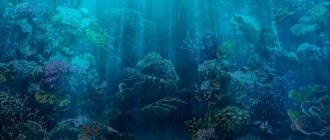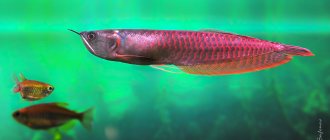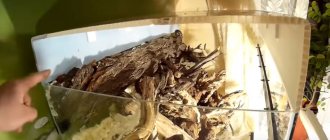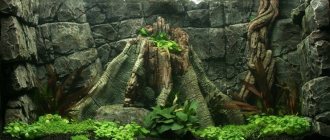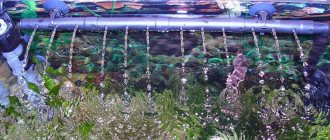Author: admin07/10/2011, 12-16 The aquarium is beautiful fish, mesmerizing sea gardens, artificial or natural corals and other invertebrates that fit well into a silent idyll. Well, and of course, equipment, a lot of equipment: filters, pumps, aerators, flow simulators, heater, thermometer, etc. It is clear that the marine surroundings, against which a shiny heater pipe can be seen, does not look very good, to put it mildly. However, to gracefully hide the equipment inside the aquarium, considerable skill and creative thinking will be required. This will not be easy for beginners, but you can get rid of the sight of electrical filters, wires and air pumps located behind the aquarium with just a background. At first glance, it may seem that such a simple decoration is not worthy of a separate article, they say, what could be complicated here? In fact, the color and texture of the background has a serious impact on the final perception of the surroundings as a whole. When talking about backgrounds, aquarists often refer to ready-made photo landscapes: the cheapest and easiest solution for those who do not plan to engage in aquascaping. The fact is that such landscapes cast a massive “shadow” on all other accessories, behind which the distinctive features of plants, stones and driftwood are hidden. Amazing and original design solutions in the presence of such bright photo landscapes turn into a simple heap of plants and accessories, the fine line between art and the forced filling of empty space is blurred, natural colors are blurred. And if you plan to show off to your guests not just the aquarium as such, but its inhabitants and decor, preference should be given to a plain backdrop. Many novice aquarists, in order not to bother with strengthening cardboard backdrops, simply paint the glass in the desired color. But things are not so simple here. Firstly, most solvents and coloring components are toxic to aquarium inhabitants, so you need to make sure that the paint does not get into the water. In addition, it is not easy to paint glass well: there are stains and areas with a thinner layer of paint through which light shines through. That. If you hurry, the painted wall will look poor. Finally, if the result does not impress you or the color has become boring over time, getting rid of the old paint, as you understand, will not be easy. And if you are a fickle person, a cardboard backdrop will suit you much better. But we must pay tribute - professional glass painting gives a more saturated color. Considering the cheapness of cardboard backdrops, I was able to try out many color solutions, so you may find some of my subjective impressions of using different colors, mixed with the theory of design skills, useful.
Why do you need a background?
In the design of a reservoir, the background plays a decorative and purely utilitarian role.
By using high-resolution photos to decorate the backdrop, the owner creates a unique atmosphere.
It will enhance the design accents placed with the help of decorations, give the aquarium additional depth and help hide the wires and tubes of all communications :
- filter;
- compressor;
- lighting devices.
View this post on Instagram
Posted by Pet Supplies (@zootsentr) Apr 15, 2021 at 4:26 am PDT
Brown, beige and light yellow
They are best suited for aquariums with sparse plantings and rocks of similar colors, creating the effect of a muddy river with a sandy bottom. Generally speaking, when choosing a color scheme for the background, you should not be afraid of experimentation. Try other colors: orange, red, gold, because these are completely safe and inexpensive experiments. I once saw with my own eyes an aquarium with a bright orange background and a huge driftwood in the middle. Do you think it looked ridiculous? Not at all, surprisingly very harmonious.
Author: AquaDreamsArt specially for nemo.by
1
How to prepare glass
All backgrounds can be divided into two categories:
- attached to the outside of the aquarium wall;
- mounted inside the aquarium.
In any case, glass or plastic must first be prepared before fixing the background.
Important! Make sure that the products used are not soluble in water and do not contain toxic elements that can poison the water.
There are many methods for attaching a background, but the principles of preparation are the same:
- Before attaching the backdrop, the glass is thoroughly cleaned of any contaminants (dust, silt, small algae).
- The wall of the aquarium is degreased - this will improve the adhesion of the glue to the surface.
- A special waterproof sealant is applied if the backdrop is mounted inside a reservoir.
- On the outside, the background is attached with glue or tape at the owner’s request.
Features of the rear design of the aquarium
The background is considered an important detail in the design of an aquarium. Its main role is to hide unnecessary elements and defects from view: the surface of the walls in the room, protruding wires inside, equipment in the container, for example, a lighting filter. In addition, the background allows you to form a general impression of the organization of the living area.
As a rule, by itself it remains almost invisible, but it adds some zest to the composition located inside the entire aquarium. The pinnacle of mastery is considered to be the case when the background wall and other decorations form a spatial perspective, an overall picture, gradually flowing into each other.
The aquarium consists of several components
Choosing a color
How to choose a background so that its palette is in harmony with the filling of the aquarium is not an easy problem, given the number and variety of options presented in stores.
However, experienced aquarists recommend adhering to several standard design solutions .
Black background
Considered a classic in aquarium design. This is the natural color of a deep-sea reservoir.
It favorably sets off the bright colors of the fish and creates an advantageous frame for the interior of the aquarium.
Even the most laconic decorative solutions on a black background acquire completeness and volume.
However, it may be difficult to perceive an aquarium designed in this way.
Many aquarists change the black backdrop over time, preferring other colors.
Light blue and green
The shades are suitable for decorating freshwater and marine aquariums.
However, when choosing such a backdrop, you need to carefully monitor the saturation of the shades so as not to blur the picture of the tropical coastal shallows.
Dark blue
Natural color of deep sea waters. Such backgrounds are usually used when decorating marine aquariums to recreate the atmosphere of coral reefs.
Against this background, tropical fish look advantageous, and the muted tone of the backdrop allows you to enjoy the view of the reservoir.
Brown, beige, sand
Such shades in the design do not distract the attention of viewers from the diversity of flora, but give a deliberately simple look and naturalness, characteristic of river backwaters .
The sandy-beige color scheme does not cause irritation over time and does not add gloom to the appearance of the aquarium; on the contrary, it gives the eyes rest and the opportunity to calmly observe the life of underwater inhabitants.
Orange and red
The aggressive, assertive option is not suitable for decorating a home aquarium . Excessive expression and pressure create an ominous atmosphere.
Few fish can fit into such a design. An aquarium with a red backdrop is too bright an accent spot in the room, drawing all the attention to itself.
But as a situational design solution (for example, decorating a themed party), such a color scheme can enhance the desired effect.
Black
Perhaps the most successful background color and, as a result, a common option. The absence of bright colors contributes to maximum concentration of attention on the inhabitants of the aquarium and aquascaping. Due to the contrast with black, the color of plants and fish becomes more expressive and bright. Black color creates the illusion of dissolution of the back wall - the gaze endlessly tends to some constantly receding focal point. As a result, the aquarium appears deeper. On the other hand, black is not as pleasing to the eye as bright colors, and therefore can cause some dullness.
Types of background
Specialty stores offer design options that are suitable for almost any aquarium. Many backgrounds offer the ability to combine elements .
Film
The advantages of film backgrounds will undoubtedly be their diversity. The Juwel backdrops alone are worth it!..
Their unique double-sided posters with realistic plant motifs or underwater landscapes on one side and imitation of three-dimensional stonework on the other will undoubtedly decorate a pond.
View this post on Instagram
Posted by Pet Shop in Kemerovo (@kemzoo_42) Dec 13, 2021 at 4:37 PST
The main problem in installing a film background is gluing it without bubbles . You will need a soft cloth and a squeegee - a tool for smoothing the film.
Attention! Don’t be intimidated by the name - a regular bank card is often used as a squeegee.
Raised
Volumetric backgrounds are good for interior design. They are used as part of the composition and can serve as a support for other decorative elements .
The main difficulty in using a 3D background is that it is difficult to clean.
How to make a background with your own hands
Many aquarists prefer to make aquarium backdrops themselves, so that it takes into account the nuances of design.
From film
Modern printing methods make it possible to print any high-resolution photo on film .
Even if you couldn’t find a ready-made background in the store, the landscape you like can be transferred to film at an advertising agency.
Advantages of film backgrounds:
- quite easy to install;
- can be mounted both on the outside of the aquarium and inside the tank;
- various topics;
- The background pasted on the outside of the aquarium can be easily replaced with another one.
Minuses:
- difficult to glue the first time without any defects (bubbles may remain);
- Do not use tape or water-soluble glue when installing inside the aquarium.
Volumetric foam background
A 3D background can be quickly assembled from pieces of foam plastic. This is a simple and effective way to create decorations without significant costs . To create such a backdrop you will need:
- Styrofoam;
- waterproof sealant;
- acrylic paints;
- brush;
- knife.
The foam is broken by hand to create the most natural pieces that look like stones. They are placed on a sheet of paper, which in size corresponds to the wall of the aquarium where the backdrop will be attached.
The “stones” are glued together using sealant or other non-toxic waterproof glue. After the glue has dried, the backdrop is painted and allowed to dry.
A mandatory step before installing the decoration will be soaking in clean water so that all harmful elements have time to dissolve and do not harm the inhabitants of the aquarium.
This version of the decorative screensaver is fixed in the tank using sealant or silicone glue, carefully coating the edges of the structure to avoid water ingress.
3D foam background
This relief background is easy to make with your own hands . For production you will need:
- a container of polyurethane foam;
- polyethylene;
- epoxy resin;
- pebbles, artificial plants and other decorative elements;
- acrylic paints;
- glue.
Creating an original background is easy. A layer of polyurethane foam is applied to the prepared polyethylene, cut to the size of the aquarium wall (it must be taken into account that it greatly increases in volume).
Until the foam sets, place pebbles at the bottom of the structure to provide stability. Then a second layer of foam is applied.
At this stage, you can place particles of decorative stones, shells, plastic plants or other decorative elements into the foam.
After the foam has dried, the backdrop is coated with epoxy glue and allowed to dry. The penultimate stage of work is coloring.
Then the background is soaked in clean water and the backdrop is mounted in the aquarium.
From cork bark
This is a very simple option for decorating an aquarium . The bark of the cork tree is pre-cut to the size of the glass and thoroughly washed with water, and then fixed to the glass with glue.
Made from polystyrene foam and stones
This option combines work with natural and artificial materials . Large stones are carefully cut into two halves and placed at the bottom of the background for stability.
The upper part is assembled from polystyrene foam, painted with acrylic paints.
Glass painting
A simple way to decorate the outside of an aquarium wall.
Of course, to create a highly artistic landscape you need some skills , but painting glass in one color (blue or green) will not be difficult.
Background of living plants
A beautiful, but rather complex way of design . It is best to use moss for such a design as it is the most undemanding species. What else will you need:
- plastic mesh, 2 times the length of the aquarium glass;
- suckers;
- fishing line
Moss is placed tightly on the mesh layer, suction cups are installed - with their help the background will be attached to the glass.
Then they cover it with the second part of the mesh and use fishing line to secure this kind of “sandwich” so that it does not open and the entire structure does not crumble.
All that remains is to place the living background in the tank and carefully press the suction cups so as not to damage the delicate branches.
Gradually the moss will grow and cover the base mesh. However, its growth will not stop there, and the green wall will need to be trimmed regularly - this is the main difficulty with a living backdrop.
Attention! Microelements necessary for crop growth are added to the water.
What types of backgrounds are there: differences in material and type of construction
The available options differ from each other in characteristics, which sometimes act as advantages and sometimes as disadvantages of a particular solution:
- BOPP film is an inexpensive, easy to install option. Standard equipment is used for printing. The basis is usually taken from an image of the underwater world, sea or freshwater landscape, sometimes along with plants, photographed fish and other creatures.
- Image painted with acrylic paints. This is a popular type of interior background for an aquarium, the production of which is usually entrusted to experienced artists. Having chosen safe, waterproof paint, they paint patterns and designs at the owner’s request: the sea or river bottom, algae, stones, sunken ships, and so on. But this method is very expensive and requires careful use.
- Background made of polyresin or ceramics. Installed inside the aquarium volume. The background can imitate stonework. Tree bark, roots. The material from which the background is made is non-toxic and easy to clean, which is why it has recently become increasingly popular. Its only disadvantage is the reduction in the useful volume of the aquarium.
- Natural, living background made of moss, other plants, stones. Brings the aquarium environment as close as possible to what an observer would find in the wild. Requires a considerable investment of time, effort and money. But the design turns out to be environmentally friendly, does not harm the health of the inhabitants, and with due diligence, it also creates a favorable environment for them to relax and reproduce.
Additionally, polymer, metal, and glass structures are used. They imitate corals, stones, elements of a “pirate” environment, high-tech style and much more. Even the most demanding and experienced aquarist will not have any problems with choosing a background for an aquarium. The manufacturer will offer a variety of options - both in cost and in terms of the impression they make.
How to glue a background to an aquarium
The method of attaching the background depends on which side it is planned to be mounted on, and on the type of backdrop.
So, 3D backdrops are mounted inside the aquarium, and the film is glued both inside and outside.
Soapy solution
This fastening method cannot be considered durable; It is only suitable for external fixation of film background.
Glycerin
You cannot work with glycerin inside an aquarium: it will not fix the background and will have a negative impact on the aquarium ecosystem.
Glue
When choosing this fixation option, you need to carefully read the instructions. The composition must withstand constant exposure to water and not dissolve in it.
Scotch tape
Installation with adhesive tape cannot be carried out inside the aquarium, since the strip with an adhesive layer will not stay in water. External design elements can be attached to adhesive tape.
A decorative background can radically change the appearance of an aquarium , highlight its advantages and hide minor defects. But choosing the right one is not an easy task.
Sometimes more time is spent on finding a good option than on the actual installation, but the efforts will more than pay off with the unique look of your artificial reservoir.
You might be interested
Aquarium filter fillers
7 Best Aquarium Soils
Automatic aquarium feeders: which one to choose?
How to choose a heater (heater) for an aquarium




